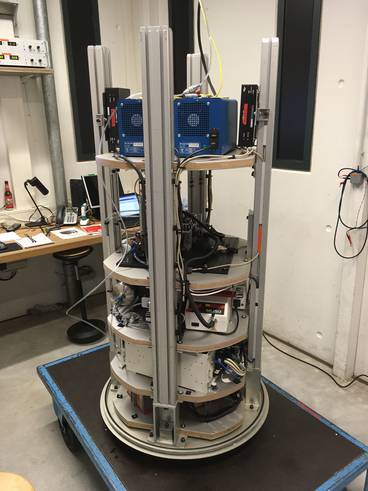Photoelectrochemical Water Splitting and Hydrogen Generation in Microgravity Environments (PhotoEChem)

research area: chemistry
experiment title:
Photoelectrochemical Water Splitting and Hydrogen Generation in Microgravity Environments
experiment acronym: PhotoEChem
funding agency: ESA (2016) / DLR
grant number: CORA Program (2016) / 50WM1848
performing organization:
ESA - Advanced Concepts Team, ESTEC, The Netherlands (2016) /
University of Warwick, United Kingdom
prime investigator:
Dr. Katharina Brinkert
experiment objective
abstract
Artificial photosynthesis systems, which follow the concept of the Z-scheme of natural photosynthesis, are of great interest in the search for sustainable, low-carbon replacements for fossil fuels. Particularly, the direct generation of hydrogen in catalyst-functionalized photovoltaic tandem devices by the photoelectrochemical oxidation of water represents a viable route to establish a carbon-neutral energy infrastructure. Although the thermodynamic potential difference to split water into H2 and O2 is 1.23 V, the required minimum photovoltage for the photolysis of water is ≳1.6 V, which is due to the catalyst reaction overpotentials and solution resistance, comprising ion transport and membrane conductivity. Processes, such as gas bubble formation and -dynamics, convective transport and pH gradients on the electrode surface influence the achievable output of the system. Additionally, the bubble size provides a dynamic change in active catalyst and photocatalyst area and (photo)corrosion of the device can be influenced by the bubble formation dynamics.
Investigations of the H2 and O2 gas bubble formation in water electrolysis cells is of strong interest in micro- and hypergravity research with respect to the realization of an effective air revitalization system for the long duration of space missions. Micro- and hypergravity environments have been demonstrated to have a significant impact on the gas bubble evolution behaviour and the mass transfer rate of the dissolved gas due to the suppression of natural convection. Furthermore, microgravity conditions cause an increase in the ohmic resistance of the gas bubble dispersion zone in proximity to the electrode, which subsequently affects the overall cell-voltage.
This work aims at obtaining first insights picture of photoelectrocatalytic generation of H2 gas bubbles under various gravitational conditions and its influence on the current- voltage characteristics and the overall solar-to-hydrogen efficiency of a catalyst functionalized semiconductor-based half-cell. For the photoelectrocatalytic generation of hydrogen, p-type indium phosphide will be used, which is - when modified with noble metal catalysts such as rhodium or platinum - one of the most efficient known photocathode materials. 3D analysis of the genesis and further development H2 gas bubble formation in micro- and hypergravity environments will be carried out, obtaining a spatial visualization of the bubble formation, track individual bubbles and study their dynamics as they form and interact. Simultaneous studies of the photocurrent-voltage characteristics of the half-cell will provide further insights into the function and efficiency of the half-cell and will be complemented by studies of the effect of different electrolyte concentrations, pH values and reaction temperatures. Spectroscopic analysis of the electrode surface before and after each experiment will complete the series to obtain insights into the effect of gravitation on the surface structure and composition during the experiment.
The overarching goal of the project is to gain fundamental knowledge of the effect of gravitation on the photoelectrocatalytic generation of H2 and to provide the basis for the development of efficient prototypes for unassisted water splitting that operate in micro- and hypergravity environments.
related publications
- Lewerenz, H.-J., Heller, A., Miller, B., Malm D., Aspnes, D. E. Semiconductor Interface Characterisation in Photoelectrochemical Solar Cells: The p-InP(111) A-Face. J. Am. Chem. Soc. 104, 3325 (1982).
- Lewerenz, H.-J., Schulte, K. Combined Photoelectrochemical Conditioning and Surface Analysis of InP Photocathodes: I. The Modification Procedure, Special Issue on Surface Modification of Semiconductors in: Electrochim. Acta 47, 2633 (2002).
- Kiuchi, D., Matsushima, H., Fukunaka, Y., Kuribayashi, K. Ohmic resistance measurement of bubble froth layer in water electrolysis under microgravity. J. Electrochem. Soc. 153, E138-E143 (2006).
- Lewerenz, H.-J., Heine, C., Skorupska, K., Szabo, N., Hannappel, T., Vo-Dinh, T., Campbell, S. H., Klemm H. W., Munoz, A. G. Photoelectrocatalysis: Principles, Nanoemitter Applications and Routes to Bio-inspired Systems. Energy & Environm. Sci. 3, 748-761 (2010).
- Matsushima, H., Iida, T., Fukunaka, Y. Gas bubble evolution on transparent electrode during water electrolysis in a magnetic field, Electrochim. Acta 100, 261-264 (2013).
- Sakuma, G., Fukunaka, Y., Matsushima, H. Nucleation and growth of electrolytic gas bubbles under microgravity, Int. J. Hydrog. Energy 39, 7638-7645 (2014).
- Majima, W., Matsushima, H., Fukunaka, Y., Ueda, M. Observation of Three-Phase Interface during Hydrogen Electrode Reactions in Unitized Regenerative Fuel Cell, J. Electrochem. Soc. 161, F1002-F1005 (2014).
- May, M. M., Lewerenz, H.-J., Lackner, D., Dimroth F., Hannappel, T. Efficient direct solar-to-hydrogen conversion by in situ interface transformation of a tandem structure. Nat. Commun. 6, 8286-8398 (2015).
- Brinkert, K., Richter, M.H., Akay, Ö., Liedtke, J., Giersig, M., Fountaine, K.T., Lewerenz, H.-J., Efficient solar hydrogen generation in microgravity environment, Nature Comm. 9, 2527 (2018)
- Brinkert, K., Akay, Ö., Richter, M. H., Liedtke, J., Fountaine, K. T., Lewerenz, H. J., Giersig, M. Experimental Methods for Efficient Solar Hydrogen Production in Microgravity Environment. J. Vis. Exp., 154 (2019)
experiment campaigns
experiment year: 2020
number of catapult launches: 12
experiment year: 2019
number of catapult launches: 26
experiment year: 2016
number of catapult launches: 16


 "
"